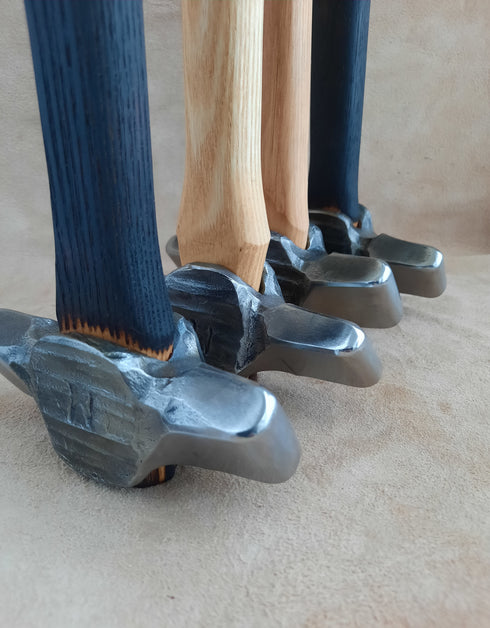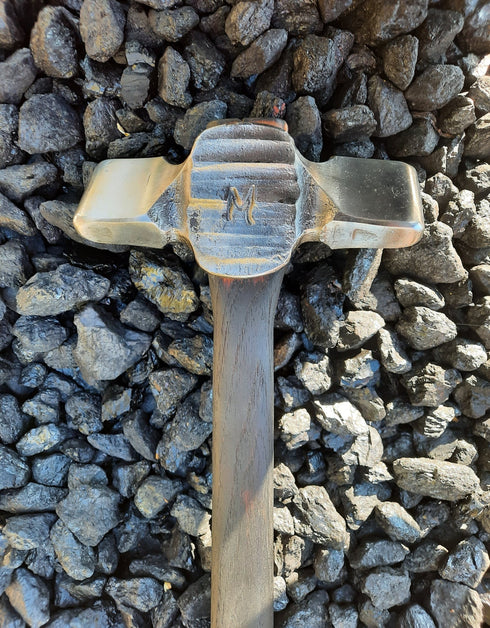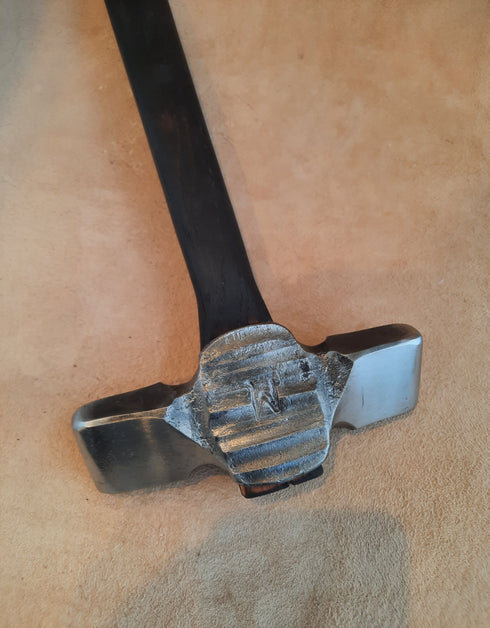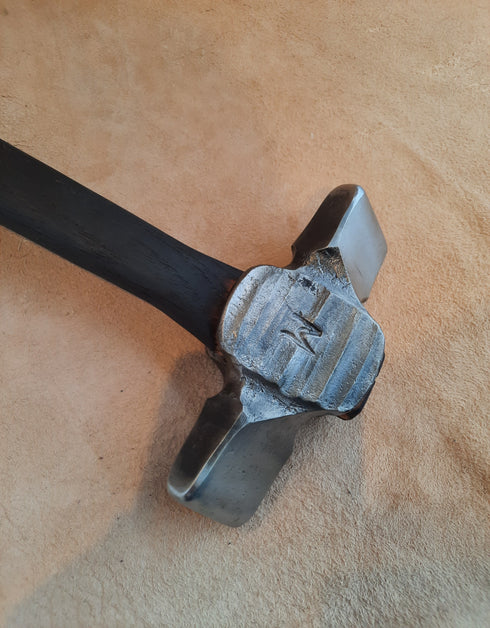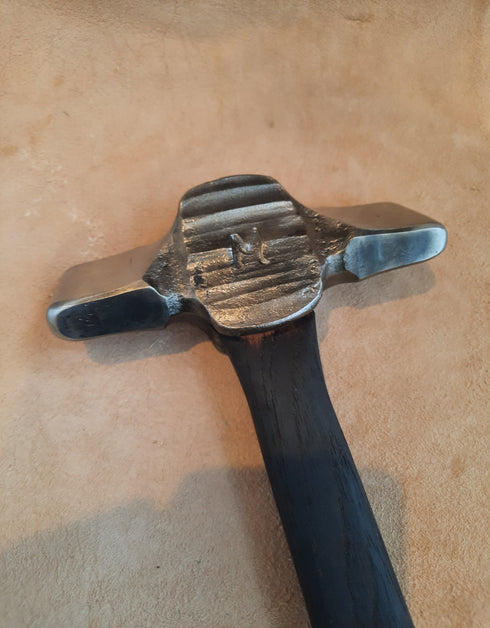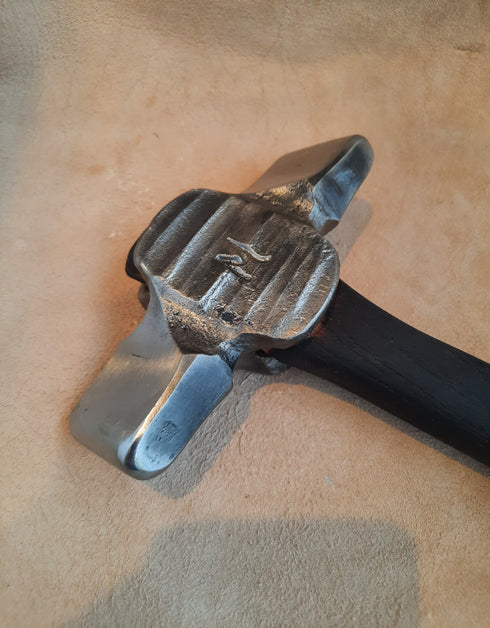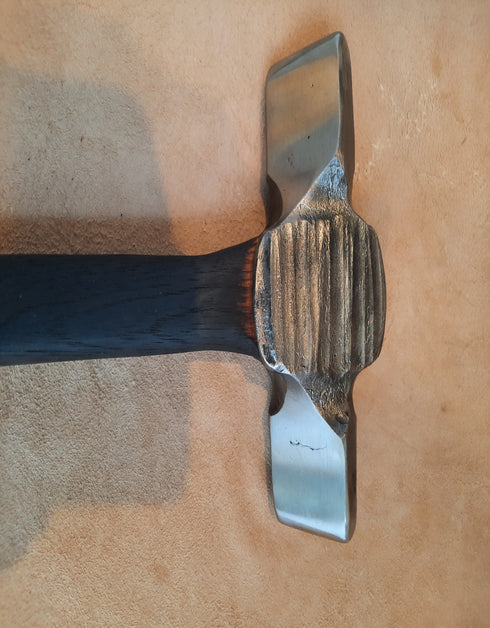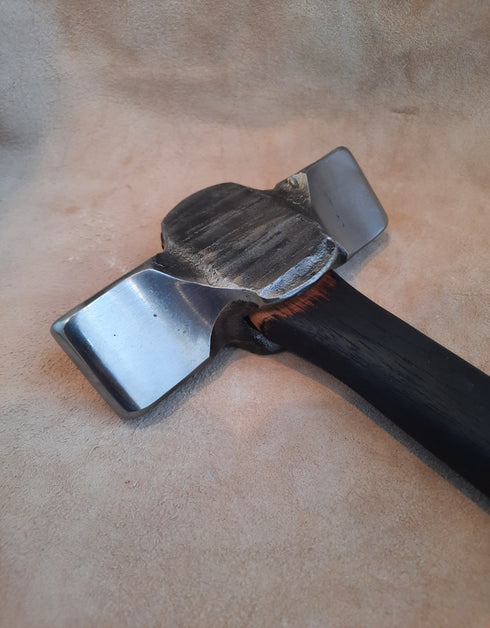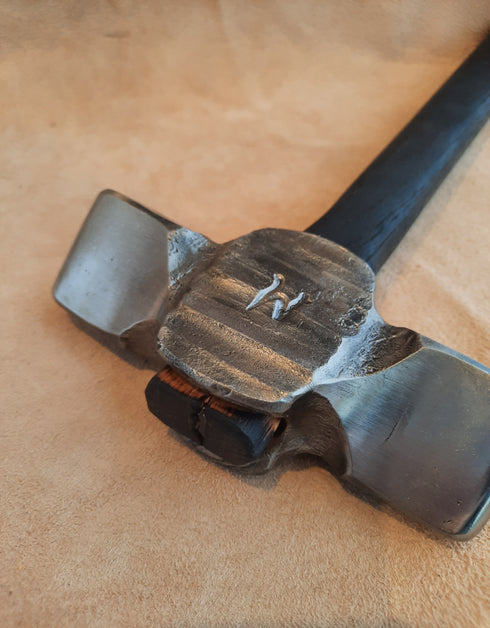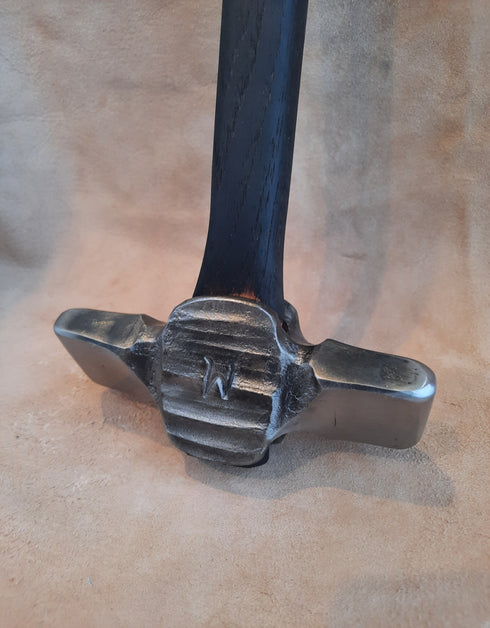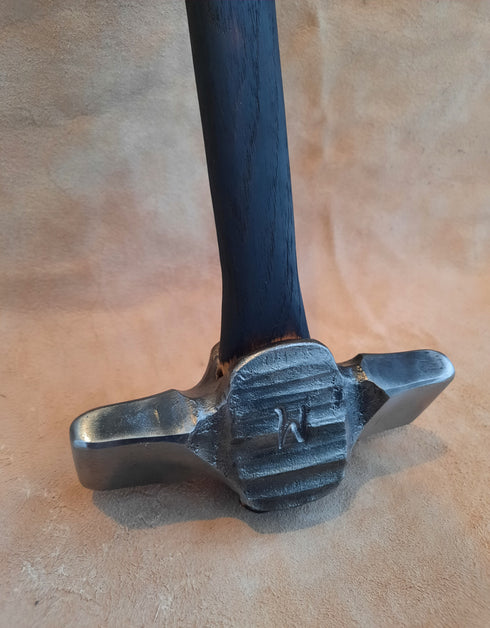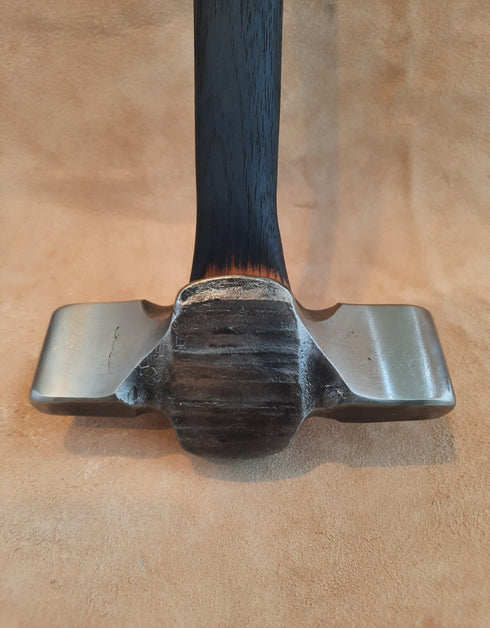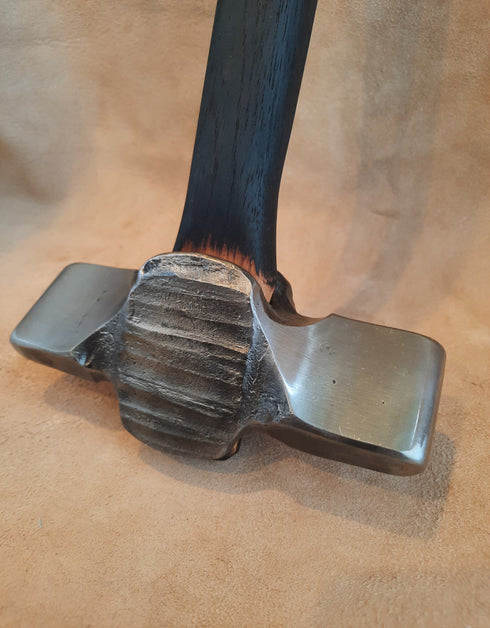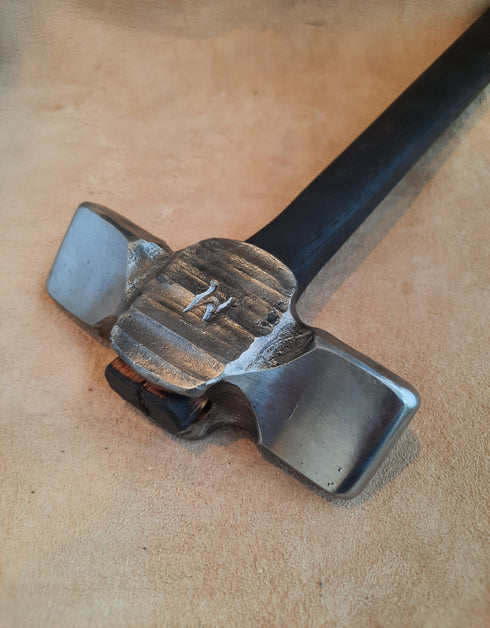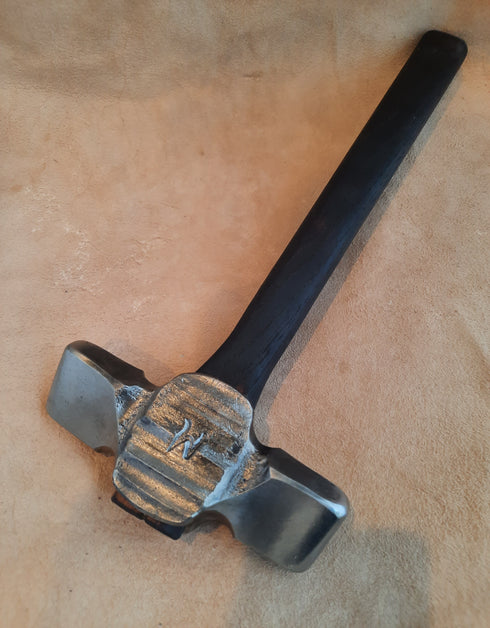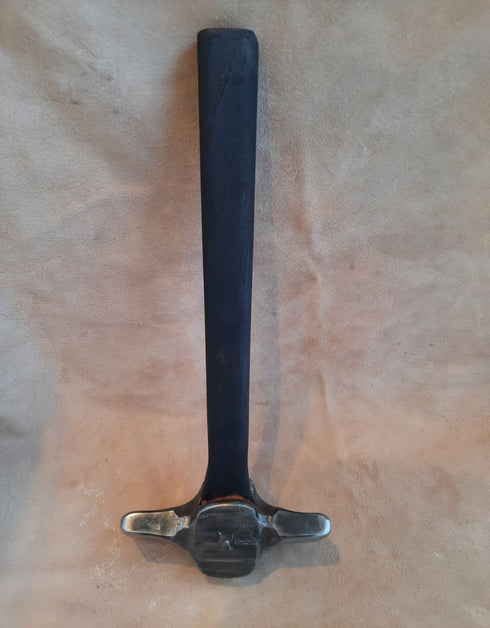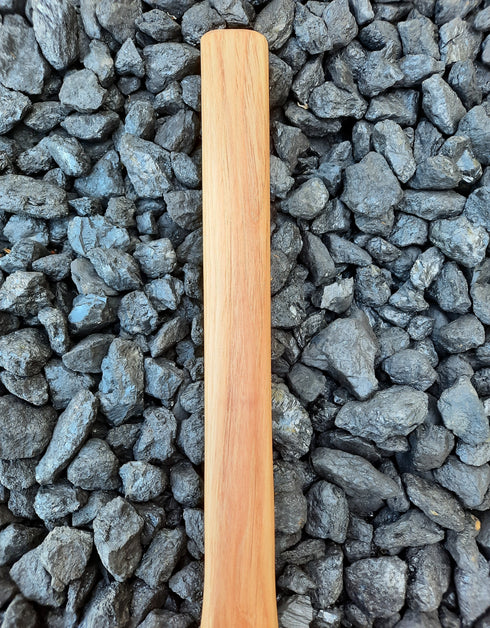Double Diagonal Cross Peen Hammer
The double diagonal cross peen is a job specific hammer and not suited for the general tasks of turning decorative work but do however excel at the singular task of forging blades. With this hammer, one peen ends up perpendicular to your workpiece and the other ends up parallel to it: perfect for drawing out and spreading. It is a unique peen that allows a true 90 degree blow without twisting your wrist.
Our hammer heads are forged from new 1045 medium carbon steel, water-quenched, and oven-tempered, for a consistent and long-lasting tool. These are crafted with the use of forges, a press, power hammer, and hand-forging. They are rough grinded and then heat treat and tempered so that they are tough without being brittle. They have a finish sand and polish to the striking surfaces.
We typically make hammer head weights in: 2 lb, 2.5 lb, 3 lb, 3.5 lb, 4 lb and 4.5 lb.
Please contact us for other head weights. Please allow up to a few weeks of crafting time for a custom hammer.
Our handles are made from hickory and are available in natural/oiled or charred/oiled finishes. The handle is held in by one wooden wedge and one steel wedge and glued on assembly and is shaped to fit the hand nicely.
Keep in mind that handles add some weight to the hammer. Handles are around 400-450mm long to allow shortening to the desired length.
Note: The hammer shown in the photos may be a representation of the one you'll receive. If you wish to see photos of the exact hammer you'll be purchasing, please let us know.
Hammer Weights
Blacksmithing hammers are usually divided into three groups for weight:
- Small size hammers - 1.1 to 2.2 lbs (0.5 to 1 kg)
- Medium size hammers - 2.2 to 4.4 lbs (1 to 2 kg)
- Large size hammers - greater than 4.4 lbs (greater than 2 kg)
Small size hammers offer higher precision and control, allowing you to work longer due to the lightweight. If you are doing small-scale items, small hammers are ideal and probably the only choice.
Medium size hammers allow you to work with larger pieces. They can also create shapes with broader areas of the surface. In some cases, small hammers are too small, and large ones are too large, so medium hammers are a choice in those cases.
Large size hammers are the choice when heavy striking is needed. They are recommended on items that require the construction of extremely wide planes and for punching the metal due to the high force they can produce.
While a heavier hammer is faster and more efficient, you shouldn’t use a hammer that is heavier than you can wield with control. While weight is a matter of personal preference, it is usually recommended that beginners start with a lighter hammer, because even a light hammer can start to feel very heavy after an hour of use.
Buyer Information
Order & Shop Information
All items are handmade and sold as they are. Each hand crafted item is a little different to the next. Dimensions of items are approximate and may vary slightly.
The photos you see are of the product you will be purchasing (with exception to hammers, which may include a photo of a hammer in an alternate size). If you would like additional photos of a product, please contact us.
Placing an order indicates your acceptance of our Returns Policy.
Disclaimer & Age Restrictions
Please remember knives are age restricted items. The purchaser is responsible for following all local laws and regulations regarding our products.
When you purchase from us, you are confirming that you are an adult and making a legal purchase. We take no responsibility for any illegal purchase and will not be liable for any harm, damage and injuries that may result from the use. The blades on our products are sharp and must be used responsibly and with due care.
Order Cancellation Fees
We reserve the right to recover processing fees on orders that are cancelled after they are placed but before they are shipped.
Payment Information
The currency of our online shop is New Zealand Dollars ($ NZD). Prices include 15% GST and are subject to change without notification. Product pricing does not include shipping; this is separate from the purchase price of a product. Full payment is required before your order is shipped.
Payment for custom-crafted items require a non-refundable 60% deposit. The non-refundable deposit is determined by the cost of the item being commissioned with a minimum non-refundable deposit of $100 NZD. The balance (40%) is due on notification of completion within 14 days or the product and deposit are forfeit.
We use Shopify Payments to accept payments online. This is a secure payment processing platform to process your payment, and we never come into contact with any of your financial information. Payments can be made in your local currency using your preferred payment method.
The following payment methods are offered at checkout - Visa, MasterCard, American Express, Google Pay, Apple Pay, Shop Pay, Paypal and POLi.
If you would prefer to charge your purchase and pay via bank transfer, please contact us to request a tax invoice and our bank details.
Shipping & Delivery
If you have purchased an item in stock, it will generally be sent within two working days. Working days are Monday to Friday, excluding New Zealand public holidays.
If you have ordered an item in stock and custom-crafted item, your order will be sent once all items are available, i.e., they will be sent in one package. If you request for items to be sent separately (i.e., a split shipment), two shipping fees may be incurred.
To ensure safe arrival all items are shipped in boxes or mail bags (depending on the item ordered) with appropriate protection. All items are tracked. We make contact, through the email address supplier at the time of order, to advise when an order has been shipped and provide the tracking information.
Shipping costs may be adjusted further when your order is processed, according to weight and any difference refunded or paid, as appropriate.
Domestic (within New Zealand)
We generally use New Zealand Post tracked service, with a delivery target of 1-3 working days in New Zealand. Delivery to rural areas may take longer than the times indicated. Tracking is via https://www.nzpost.co.nz/tools/tracking. On occasions we may use another shipping carrier depending on the size or weight of an item. Tracking details will be emailed on shipment of your order.
Delivery delays can happen for reasons outside of our control, such as interruptions from the Covid pandemic.
International
We can ship worldwide and provide a shipping quote for countries further afield than New Zealand. Please contact us and provide information on the item you wish to purchase and the country we would be sending to. International shipping delivery times depend on your location and can sometimes take up to four weeks for delivery. We are not responsible for any items lost or stolen in transit.
Note: International orders may incur a customs tax that the buyer will be responsible for. You will need to contact your local customs office to find out what the customs tax might be for importing goods from New Zealand.
Damaged Goods
If your parcel is damaged during transit, please contact us immediately upon receiving the item and email through photos of your parcel so we can follow up. Claims for any damage (or loss) in transit will be made against the shipping carrier.
Returned Packages
If a package is returned to us due to customer error, such as a mistake in the shipping address provided with the order, the recipient moving, or any other reason beyond our control and responsibility, the customer is responsible for covering the cost of reshipping the item. Original shipping costs are non-refundable.
Change of Address
As we may have already arranged a shipping label for your order prior to you updating the address in your account on the website, if you wish to change the delivery address, please also notify us of the change by email.
Caring for your Knife
Knife Blade Care - Carbon Steel
Like many products made of premium material, carbon steel suits those who take pride in keeping their tools at peak performance through basic maintenance. While day-to-day it’s as simple as making sure your knife stays clean and dry when it’s not in use, below provides some guidance to what you can do to ensure your knife stays in the best condition possible and serves you well for years to come.
High carbon steel is a tough and long-lasting steel and will keep an edge for longer than stainless steel. The only downside is that it will rust if you do not take care of it. Keep your knife as clean and dry as possible after use and apply a light coating of oil on your knife periodically to maintain it in peak condition. For applications where knife will encounter food product, use a food safe oil. If you forget and the blade does develop light rust spots, these can be carefully rubbed away with fine steel wool.
High carbon knives can develop a “patina” (which is a thin layer that forms on the surface of the knife, caused by oxidation). This is perfectly normal, and a sign of quality and the patina will protect it from rusting. A knife of high carbon steel should be kept dry and oiled to minimize the chances for rust as it develops its protective patina.
Do not put in the dishwasher - the high temperature and dishwasher soaps can damage the steel, the edge of your blade and degrade the handle. It is recommended not to wash it - merely wipe it over as soon as you have finished using it and put it away. You can wash by hand if need be, but refrain from using any strong detergent, do not leave water on it, do not soak in a sink and don’t leave it to air dry on a draining rack. Wash and dry it straight away.
When storing your knife, it is advised to not store your knife in its sheath (especially leather) as moisture can be trapped against the blade.
Steel your knife as needed to help retain the edge. Do not burn or overheat the blade when sharpening. This will cause damage on blade properties. Used properly your knife should only have to be put on a sharpening steel once a week. This is if you are using it on a daily basis.
Please use the knife for the purpose it was made for. Don’t use the knife as a lever, hammer, shovel, screwdriver etc, and don’t cut on a glass, stone or steel surface (use wood or plastic). Our blades are superbly designed and if you take care of it well, it will last a lifetime.
Knife Handle Care
Handle materials all expand and contract at different rates in response to variance in temperature and environmental moisture. Synthetic materials expand and contract very very little within the normal temperature ranges in which a knife exists.
Natural handle materials (such as wood, antler, horn and bone) expand and contract to a larger extent than synthetics and metals. Their porous, fibrous, and often absorbent nature can get them into trouble with moisture, while being next to or surrounding materials that don’t. It is recommended to keep your knife in a dry location, lightly oiled and reasonably temperature regulated. Do not store in places where humidity fluctuates as temperature changes can lead to the knife handle shrinking, swelling and/or cracking.
Some types of wood are more susceptible to drying out than others. Wooden handles that look dry and dull can be refreshed with mineral oil, Danish oil, or other penetrating wood oils, by applying with a clean cloth as per the manufacturer’s recommendations for that product. Oiling can prevent cracks and increase the resistance against changes in temperature and humidity.
Stabilised wood handles won’t need as much oil (as the non-stabilized types of wood). The stabilisation process removes voids for moisture from the wood via a vacuum chamber to suck out all the air. An acrylic resin is introduced, it saturates the wood and then is cured. The result is a stable piece of wood that is greatly protected from moisture and the timber gains more effective protection against humidity changes. Despite being saturated with acrylic resin, the knife handles still look and feel like wood instead of plastic.
Please contact us with any questions on the care and maintenance of your knife.
Caring for your Axe/Hatchet
Please use the axe responsibly and within design guidelines. If you take care of your axe and maintain it, it can last your entire life.
You may use the poll of the axe as a hammer (unless we have stated that it is not designed to withstand this).
Do not hit rocks with the sharp edge of the axe. Do not use the axe as a lever or pry bar. Remember that there is always a risk in striking steel against steel. A fragment of steel could fly off and damage your eye, for example. Do not leave it out in the rain or submerged in water.
Axe Head - The head will need oiled periodically, as the steel contains iron and therefore will rust if exposed to moisture. Any variety of all-purpose oil or paste wax found in a hardware store will sufficiently protect the axe head from rust. Ensure that the axe head and the leather sheath are dry before storing.
Axe Handle - Extreme temperature can cause the handle to swell or shrink compromising the head-to-handle fit. Axes and hatchets should be kept in a dry place, but not so dry or warm that the handle risks shrinking in the head. Check routinely that the axe handle is secure in the axe head. Regularly treating the handle with wood conditioner will minimize the tendency for the handle to shrink or expand. Boiled linseed oil, paste wax and beeswax are examples of suitable conditioners.
Axe Sharpening - The sharpening of an axe is done in several steps, depending on how worn down the axe head is. Microchips can develop in the course of routine use but can be easily repaired by filing down before the sharpening process begins. The easiest method is to use an axe file (or any similar tool designed to file a steel edge). File the same amount on each side and along the edge, making sure the original shape is retained.
An emery wheel can also be used. The whole bevel face should be in contact with the wheel/file if it is a straight bevel face. Exercise caution when using a wheel; excess friction will overheat the steel and could affect the temper. If this happens, the axe will lose its ability to hold an edge.
Once the bulk of material is removed (if the edge required it using the above process), sharpening can be done with an oil stone similar to what would be used to sharpen woodworking tools (chisels, etc).
Please contact us with any questions on the care and maintenance of your axe or hatchet.



